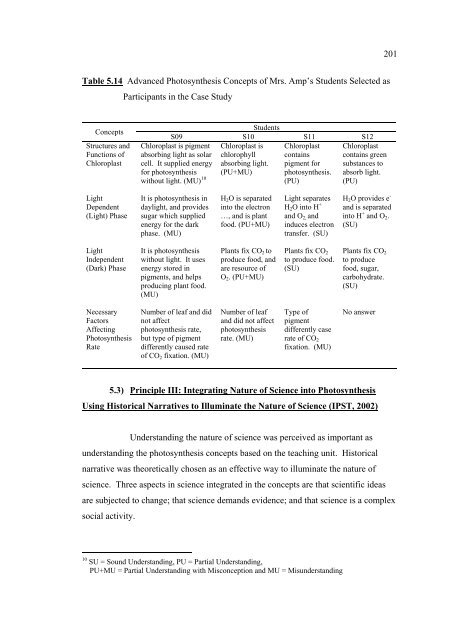an innovative approach
an innovative approach
an innovative approach
Create successful ePaper yourself
Turn your PDF publications into a flip-book with our unique Google optimized e-Paper software.
Table 5.14 Adv<strong>an</strong>ced Photosynthesis Concepts of Mrs. Amp’s Students Selected as<br />
Concepts<br />
Structures <strong>an</strong>d<br />
Functions of<br />
Chloroplast<br />
Light<br />
Dependent<br />
(Light) Phase<br />
Light<br />
Independent<br />
(Dark) Phase<br />
Necessary<br />
Factors<br />
Affecting<br />
Photosynthesis<br />
Rate<br />
Particip<strong>an</strong>ts in the Case Study<br />
S09<br />
Students<br />
S10 S11 S12<br />
Chloroplast is pigment<br />
absorbing light as solar<br />
cell. It supplied energy<br />
for photosynthesis<br />
without light. (MU) 10<br />
Chloroplast is Chloroplast Chloroplast<br />
chlorophyll contains contains green<br />
absorbing light. pigment for subst<strong>an</strong>ces to<br />
(PU+MU) photosynthesis. absorb light.<br />
(PU)<br />
(PU)<br />
It is photosynthesis in<br />
daylight, <strong>an</strong>d provides<br />
sugar which supplied<br />
energy for the dark<br />
phase. (MU)<br />
It is photosynthesis<br />
without light. It uses<br />
energy stored in<br />
pigments, <strong>an</strong>d helps<br />
producing pl<strong>an</strong>t food.<br />
(MU)<br />
Number of leaf <strong>an</strong>d did<br />
not affect<br />
photosynthesis rate,<br />
but type of pigment<br />
differently caused rate<br />
of CO2 fixation. (MU)<br />
H2O is separated<br />
into the electron<br />
…, <strong>an</strong>d is pl<strong>an</strong>t<br />
food. (PU+MU)<br />
Pl<strong>an</strong>ts fix CO2 to<br />
produce food, <strong>an</strong>d<br />
are resource of<br />
O2. (PU+MU)<br />
Number of leaf<br />
<strong>an</strong>d did not affect<br />
photosynthesis<br />
rate. (MU)<br />
Light separates<br />
H2O into H +<br />
<strong>an</strong>d O2, <strong>an</strong>d<br />
induces electron<br />
tr<strong>an</strong>sfer. (SU)<br />
Pl<strong>an</strong>ts fix CO2<br />
to produce food.<br />
(SU)<br />
Type of<br />
pigment<br />
differently case<br />
rate of CO2<br />
fixation. (MU)<br />
201<br />
H2O provides e -<br />
<strong>an</strong>d is separated<br />
into H + <strong>an</strong>d O2.<br />
(SU)<br />
Pl<strong>an</strong>ts fix CO2<br />
to produce<br />
food, sugar,<br />
carbohydrate.<br />
(SU)<br />
No <strong>an</strong>swer<br />
5.3) Principle III: Integrating Nature of Science into Photosynthesis<br />
Using Historical Narratives to Illuminate the Nature of Science (IPST, 2002)<br />
Underst<strong>an</strong>ding the nature of science was perceived as import<strong>an</strong>t as<br />
underst<strong>an</strong>ding the photosynthesis concepts based on the teaching unit. Historical<br />
narrative was theoretically chosen as <strong>an</strong> effective way to illuminate the nature of<br />
science. Three aspects in science integrated in the concepts are that scientific ideas<br />
are subjected to ch<strong>an</strong>ge; that science dem<strong>an</strong>ds evidence; <strong>an</strong>d that science is a complex<br />
social activity.<br />
10 SU = Sound Underst<strong>an</strong>ding, PU = Partial Underst<strong>an</strong>ding,<br />
PU+MU = Partial Underst<strong>an</strong>ding with Misconception <strong>an</strong>d MU = Misunderst<strong>an</strong>ding
















